Node.js in production with resounding volume traffic

Manuel Kanah
Tech Lead
at Yumpingo Ltd
http://yumpingo.com/
e-mail: manuel@kanah.it
Twitter: @testinaweb
Github: testinaweb
Blog: http://www.labna.it
VCard

Node.js
Node.js is a JavaScript runtime built on Chrome's V8 JavaScript engine. Node.js uses an event-driven, non-blocking I/O model that makes it lightweight and efficient.
Node.js operates on a single thread, using non-blocking I/O calls, allowing it to support tens of thousands of concurrent connections without incurring the cost of thread context switching. The design of sharing a single thread between all the requests that uses the observer pattern is intended for building highly concurrent applications, where any function performing I/O must use a callback. In order to accommodate the single-threaded event loop, Node.js utilizes the libuv library that in turn uses a fixed-sized threadpool that is responsible for some of the non-blocking asynchronous I/O operations
Single-threaded
A downside of this single-threaded approach is that Node.js doesn't allow vertical scaling by increasing the number of CPU cores of the machine it is running on without using an additional module, such as cluster, StrongLoop Process Manager or pm2. However, developers can increase the default number of threads in the libuv threadpool; these threads are likely to be distributed across multiple cores by the server operating system.
DSP
A demand-side platform (DSP) is a system that allows buyers of digital advertising inventory to manage multiple ad exchange and data exchange accounts through one interface.
Mongodb data structure
> db.dsp.findOne({_id: "constrain"})
{
"_id": "constrain",
"c": [
"123",
"456",
"789"
]
}The data structure allows to the dsp to work with arrays and to get the campaigns from the intersections of the arrays. The campaigns that will remain in the final array will fill the response.
Performance degradation
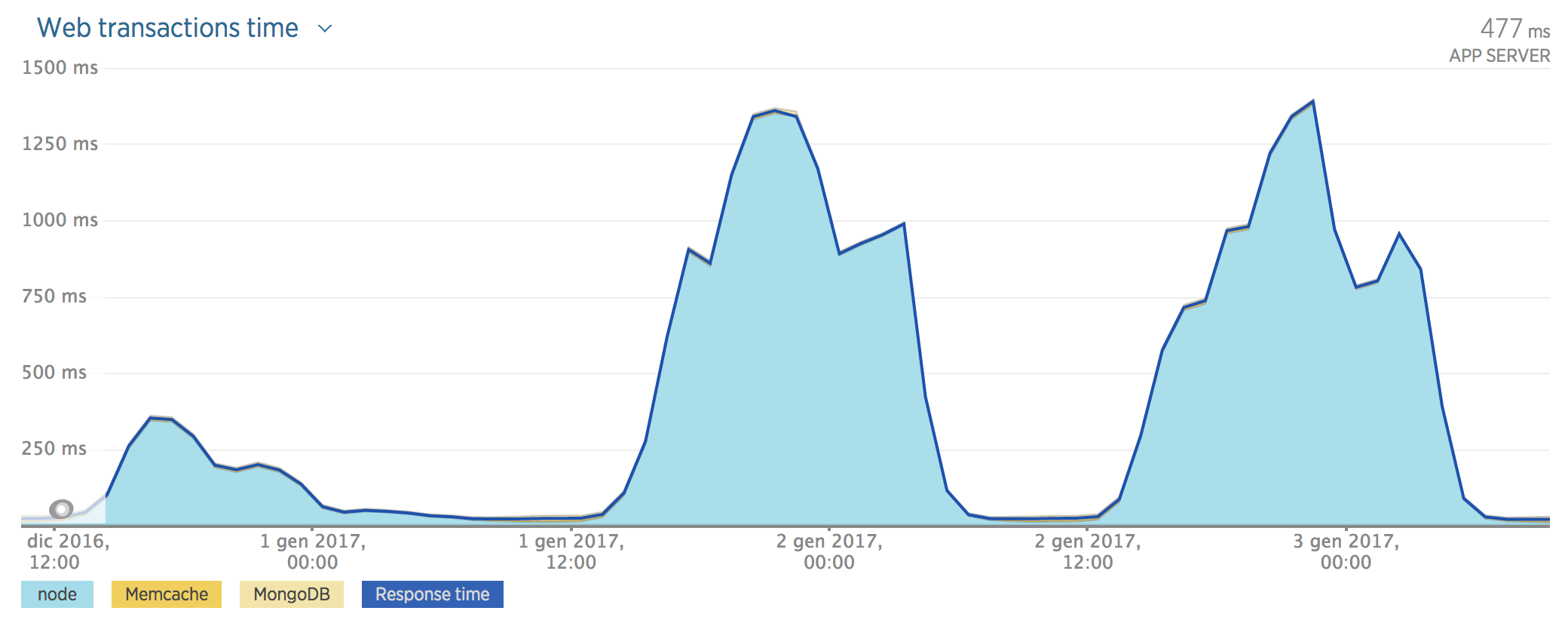
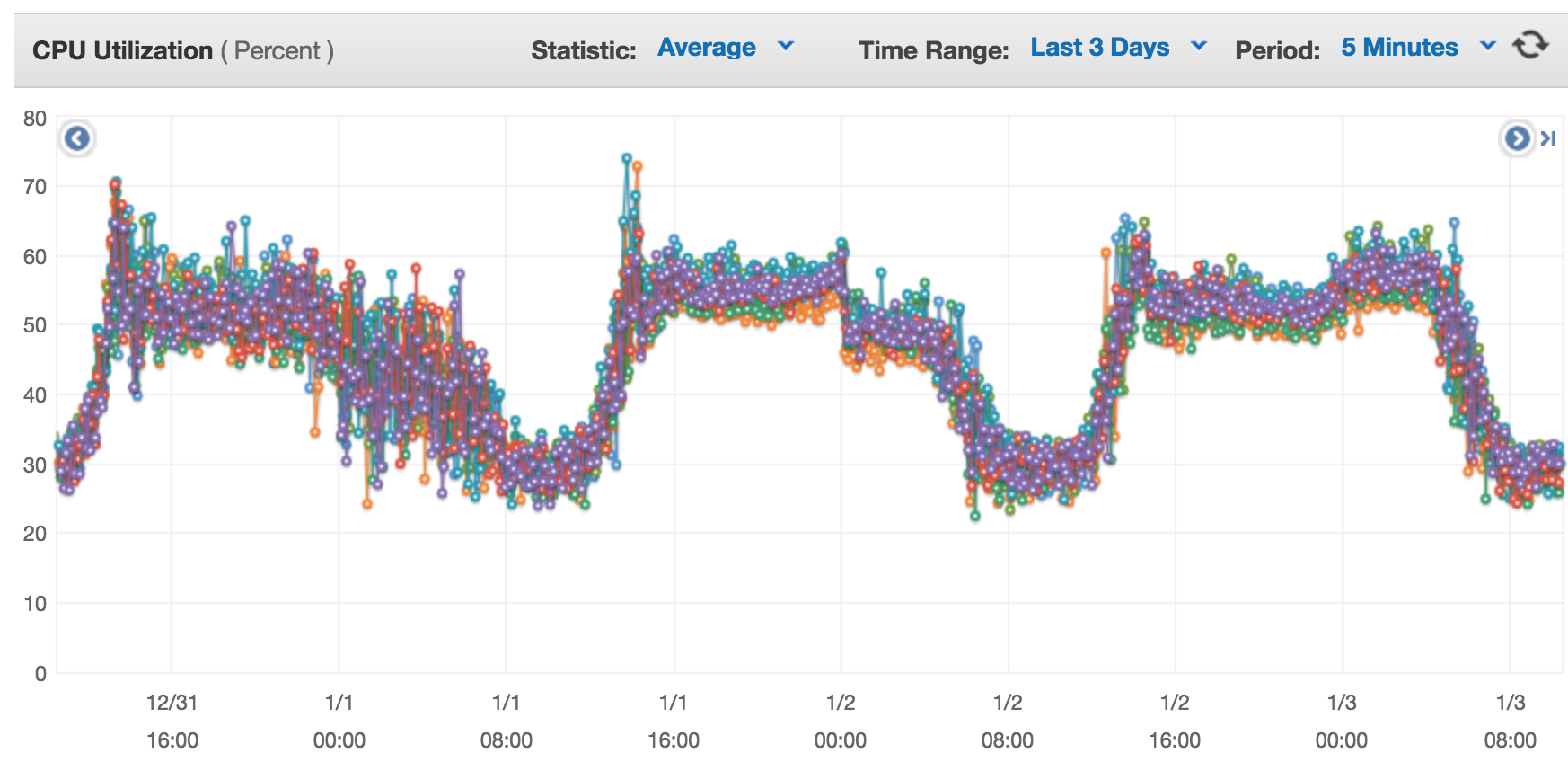
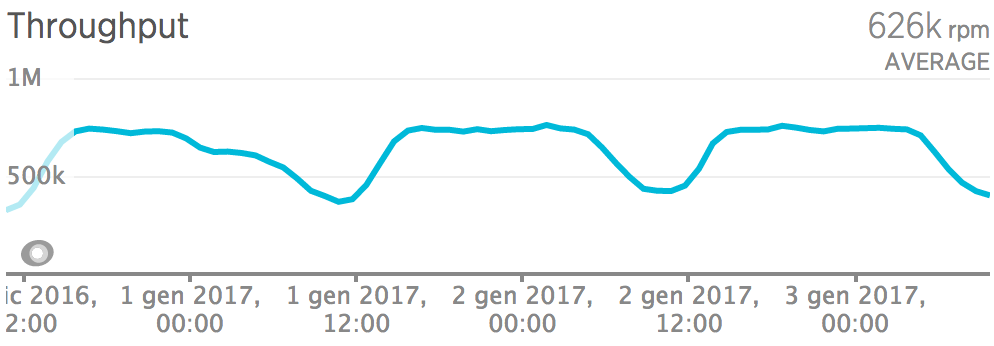
Throughput
CPU Utilization
Execution time degradation:
from 10ms to over 1250ms
PM2
Advanced, production process manager for Node.js
apps:
- script : app/index.js
instances: 0 # pm2 uses a process per core
exec_mode: cluster$ npm install pm2 -g$ pm2 start process.ymlhttp://pm2.keymetrics.io/
PM2 cluster configuration
PM2 Cluster uses a core as any other node.js process
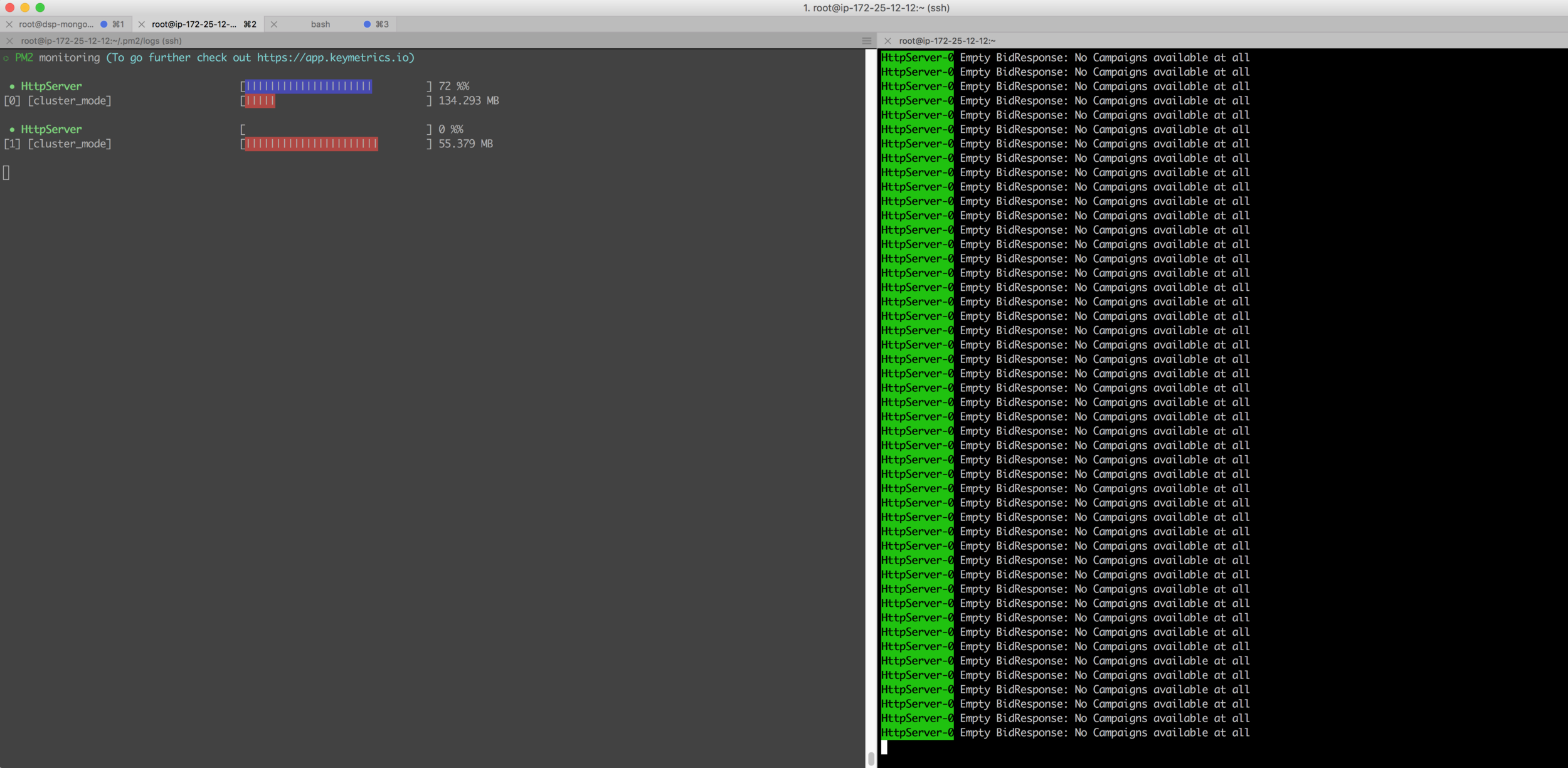
$ pm2 monit
Haproxy
HAProxy is a free, very fast and reliable solution offering high availability, load balancing, and proxying for TCP and HTTP-based applications. It is particularly suited for very high traffic web sites and powers quite a number of the world's most visited ones.
http://www.haproxy.org/
ab test
# ab -n 100000 -c 200 http://localhost/
PM2:
Time taken for tests: 38.352 seconds
Requests per second: 2607.40 [#/sec] (mean)
Time per request: 76.705 [ms] (mean)
Time per request: 0.384 [ms] (mean, across all concurrent requests)
Transfer rate: 295.37 [Kbytes/sec] received
HAproxy:
Time taken for tests: 24.791 seconds
Requests per second: 4033.71 [#/sec] (mean)
Time per request: 49.582 [ms] (mean)
Time per request: 0.248 [ms] (mean, across all concurrent requests)
Transfer rate: 464.82 [Kbytes/sec] received
CPU heap
RisingStack

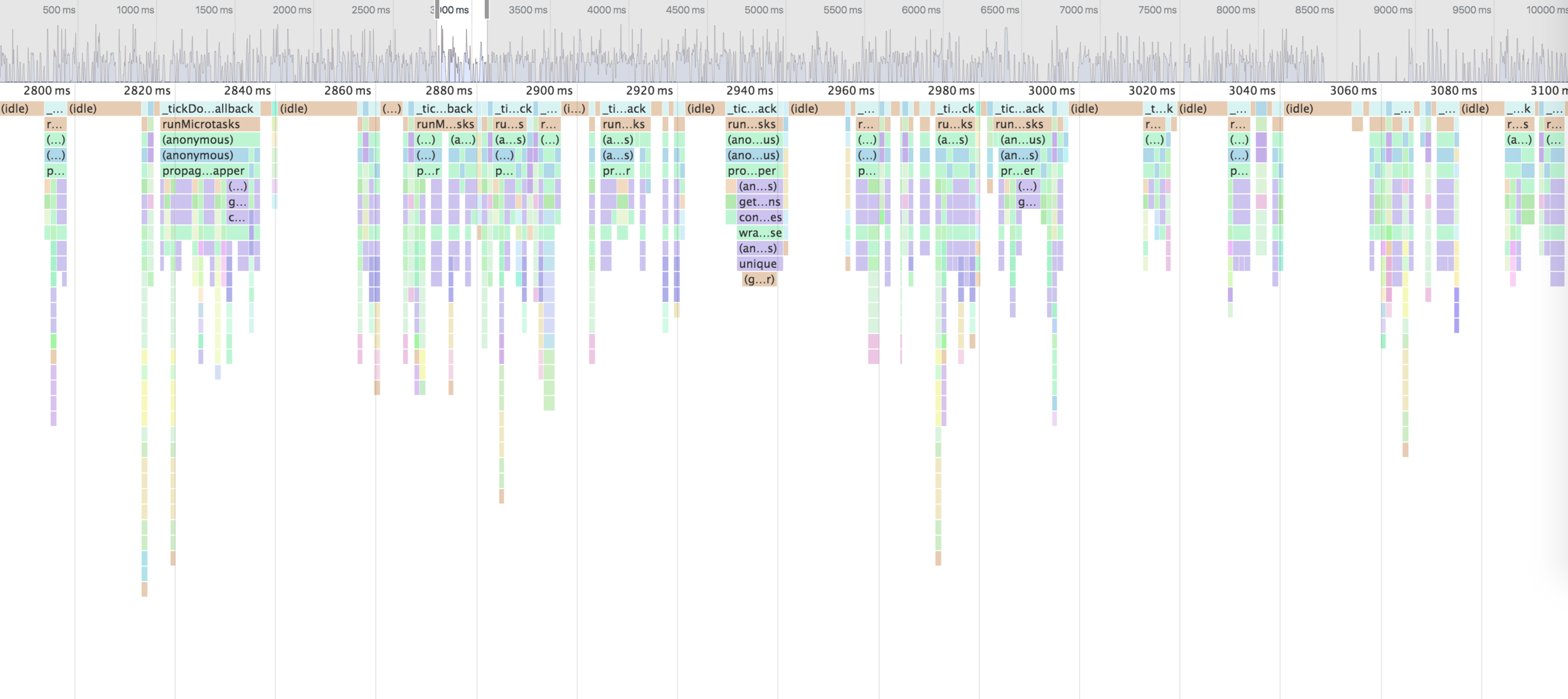
CPU profiles snapshot
https://trace.risingstack.com/
Libuv
libuv is a multi-platform support library with a focus on asynchronous I/O.
Features
- Full-featured event loop backed by epoll, kqueue, IOCP, event ports.
- Asynchronous TCP and UDP sockets
- Asynchronous DNS resolution
- Asynchronous file and file system operations
- File system events
- ANSI escape code controlled TTY
- IPC with socket sharing, using Unix domain sockets or named pipes
- Child processes
- Thread pool
- Signal handling
- High resolution clock
- Threading and synchronization primitives
http://libuv.org/
How to Libuv
process.env.UV_THREADPOOL_SIZE = 100;Var vs let

The difference is scoping. var is scoped to the nearest function block and let is scoped to the nearest enclosing block.
Variables declared with let are not accessible before they are declared in their enclosing block.
https://jsperf.com/var-vs-let-performance
max-inlined-source-size
function add(x, y) {
// Addition is one of the four elementary,
// mathematical operation of arithmetic, with the other being subtractions,
// multiplications and divisions. The addition of two whole numbers is the total
// amount of those quantitiy combined. For example in the picture on the right,
// there is a combination of three apples and two apples together making a total
// of 5 apples. This observation is equivalent to the mathematical expression
// "3 + 2 = 5"
// Besides counting fruit, addition can also represent combining other physical object.
return(x + y);
}function add(x, y) {
// Addition is one of the four elementary,
// mathematical operation of arithmetic with the other being subtraction,
// multiplication and division. The addition of two whole numbers is the total
// amount of those quantitiy combined. For example in the picture on the right,
// there is a combination of three apples and two apples together making a total
// of 5 apples. This observation is equivalent to the mathematical expression
// "3 + 2 = 5"
// Besides counting fruit, addition can also represent combining other physical object.
return(x + y);
}for(let i = 0; i < 500000000; i++) {
if (add(i, i++) < 5) {
//
}
}max-inlined-source-size
$ node --max-inlined-source-size=1000 index.js$ node -v
v6.9.4
$ time node moreThan600Chars.js # with “let”
real 0m2.119s
user 0m2.108s
sys 0m0.012s
$ time node lessThan600Chars.js # with “let”
real 0m0.800s
user 0m0.796s
sys 0m0.000s
$ time node moreThan600Chars.js # with “var”
real 0m1.557s
user 0m1.552s
sys 0m0.000s
$ time node lessThan600Chars.js # with “var”
real 0m0.322s
user 0m0.296s
sys 0m0.008s
WTF!
Lodash

https://jsperf.com/intersection-benchmark
Lodash (as Underscore) is a very power library if you will work on front end. It does its job great and it is cross browser. On fast back end it adds a lot of computation without benefits.
Garbage Collection
If you do not have memory leaks you can use manual garbage collection. This solution will avoid garbage collector to start every moment to do its job even if you do not have anything to collect.
$ node --expose-gc index.jssetInterval(global.gc, 30000);Result

{
"apps": [
{
"name": "http01",
"args": "5001",
"script": "app/index.js",
"node_args": [
"--nouse-idle-notification", # noticed reduction in pauses since GC was getting invoked
"--expose-gc", # to manually trigger gc() method
"--max-old-space-size=2048", # to increase space size for old generation objects
"--max-inlined-source-size=1000" # to increase the inlined source size
]
}
]
}

http://slides.com/testinaweb/nodejs/fullscreen
Node.js in production with resounding volume traffic
By Manuel Kanah
Node.js in production with resounding volume traffic
The talk will be about issues related to a single node js endpoint to serve an average of 2M rpm: tools, tricks, architecture, data structure
- 866



